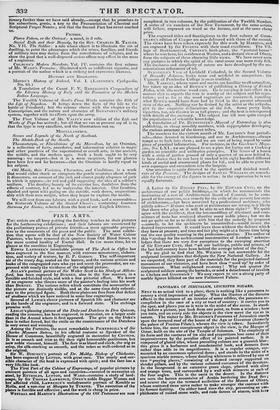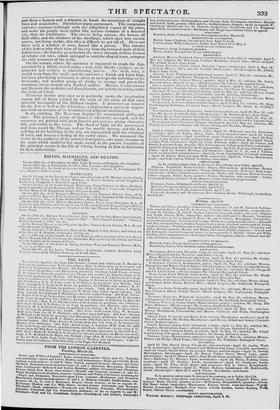PANORAMA OF JERUSALEM, LEICESTER SQUARE.
NEXT to an actual visit to a place, there is nothing like a panorama to convey .a vivid impression of reality. What the illusion of the diorama effects in the instance of an interior of some edifice, the panorama ac- complishes in the case of a city or tract of country: it carries you to- the spot, and places you as it were in the midst of the scene. In stand- ing before a picture, you look from one point, as from a window ; here you turn, and on every side the objects in the view meet the eye as in nature. The visiter to Mr. BURFORD'S Panorama of Jerusalem stands upon the terraced roof of the house of the Aga or Governor (formerly the palace of Pontius Pilate), whence the view is taken. Immediately before him, the most conspicuous object in the view, is the Mosque of Omar, built on the site of the Temple of Solomon. The simplicity of its form and the vastness of its size and proportions lose some of their impressiveness by the peculiar effect of its painted surface. Jt is composed of glazed tiles, whose prevailing colours are a greenish blue: this gives it a barbarous and unsubstantial look, and detracts from rather than adds to its magnificence. It is a regular octagon, sur- mounted by an enormous spherical dome ; and stands in the midst of a spacious marble terrace, whose dazzling whiteness is relieved by one or two "praying places," consisting of a domed canopy supported on slender pillars, and by the various coloured costumes of the devotees. In the foreground is an extensive green slope, planted with olive and orange trees, and surrounded by a wall with minarets at each of the four angles. This is the Oasis in the desert. In the distance are seen the barren mountains of Arabia bordering the Dead Sea ; and nearer the eye the terraced acclivities of the Mount of Olives, whose scattered trees serve rather to make stronger the contrast mirth its former fertility. On either hand rises the city, presenting an am- phitheatre of ruined stone walls, and rude domes of stucco, with hut
and there a fortress and a minaret, to break the monotony of straight lines and semicircles. Desolation reigns paramount. The sumptuous costumes contrast strikingly with the dilapidated aspect of the place,
and make the people seem rather like curious visitants of a deserted city, than its inhabitants. The streets being narrow, the houses all
built alike, and the windows of the dwellings, which open into narrow courts, not being visible, this idea is difficult to get rid of. Here and there only a window is seen, burred like a prison. The inmates of the houses take their view of the city from the terraced roofs of their habitations ; the females peeping into the street through orifices formed of tubular red tiles, which arranged in vandyke-shaped rows, compose the wily ornament of the walls. On the terrace, where the spectator is supposed to stand, the Aga,
attended by a Mufti, seated under a tent, with Sheiks ( judges), an
j in- terpreter and scribes, is administering usttee. An Arab, who, it would seem from the spoils and the presence a Greek and Latin friar, has been plundering a convent, is about to undergo the infliction of the bastinado; and another group of Arabs, in strange and priest-like costumes, are in custody of a Turkish soldier. Messrs. CATIDinIVOOD and HoNomt, the architect and draughtsman, are quietly sketching under the shade of a tent.
Whatever doubts may exist as to particular spots, the imagination cannot fail of being excited by the sight of the ruins of that once splendid metropolis of the Hebrew empire. It possesses an interest for the Jew as well as the Christian ; and presents a spectacle impres- sive both on account of its historical and religious associations.
In the painting, Mr. Hwtronn displays his accustomed ability and care. The principal group of figures is admirably arrmged, and the costumes are painted with great breadth and power ; giving character, life, and reality to the scene. The flood of light on the greensward and trees round the Mosque and on the marble terrace, and the hot, -arid hue of the buildings of the city, are represented with the vividness of truth, and convey a feeling of the sultry clime. We commend the visiter to the guidance of the printed description—the mute cicerone to the spots which tradition has made sacred as the precise localities of the principal events in the life of Christ, leaving to him to determine en dick authenticity.



























 Previous page
Previous page